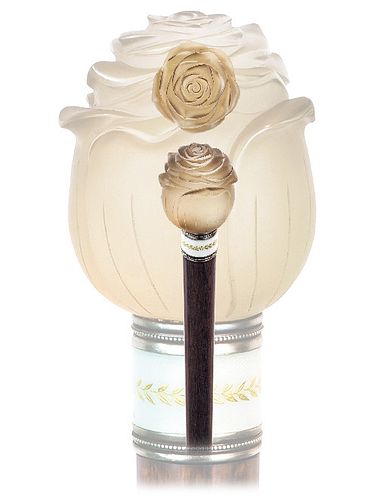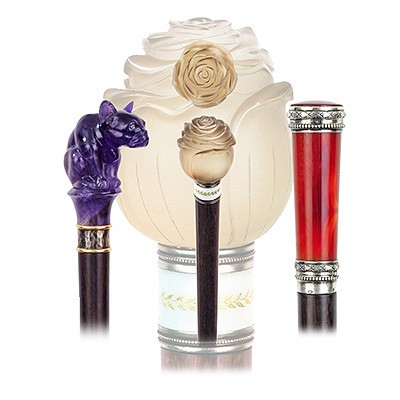Hardstone and Enamel Theater Cane
Lot 25
About Seller
Kimball Sterling
125 West Market Street
Johnson City, TN 37604
United States
Family-owned and family-run Johnson City Tennessee auction business for 25 years. Selling antiques and collectables for 38 years. Kimball M. Sterling, Inc. was founded and is owned by Kimball and Victoria Sterling, time and again, they have laid solid claim to world-wide attention and renown with an...Read more
Categories
Estimate:
$3,000 - $4,000
Absentee vs Live bid
Two ways to bid:
- Leave a max absentee bid and the platform will bid on your behalf up to your maximum bid during the live auction.
- Bid live during the auction and your bids will be submitted real-time to the auctioneer.
Bid Increments
| Price | Bid Increment |
|---|---|
| $0 | $10 |
| $100 | $25 |
| $500 | $50 |
| $1,000 | $100 |
About Auction
By Kimball Sterling
Dec 3, 2022
Set Reminder
2022-12-03 13:00:00
2022-12-03 13:00:00
America/New_York
Bidsquare
Bidsquare : The 2022 Cane Masterpiece Auction
https://www.bidsquare.com/auctions/kimball-sterling/the-2022-cane-masterpiece-auction-11295
The European Masterpiece Cane Collection Kimball Sterling kimballsterling@earthlink.net
The European Masterpiece Cane Collection Kimball Sterling kimballsterling@earthlink.net
- Lot Description
-Ca. 1900 -Topaz knob of a natural smoky fawn color fashioned in the shape of a rosebud and sensitively wheel cut with layered and overlapping petals. A smooth and frosted surface lends the bud a lovely naturalistic effect while the polished curling edges breathe life into it. -The knob is tastefully presented on a high-grade silver and enamel collar and comes with a first rate and well figured snake wood shaft and matching horn ferrule, both licenses for ultimate luxury. The collar itself is characterized by two slender and matching beaded ring edges framing a wider engine turned, iridescent white enameled band highlighted by an underglaze 24 karat micro laurel leaf encircling crown. -This high-end eminently displayable and classy cane is a gracious link to a romantic past when fine manners requested from the gentleman to wear a stick with rose for an elegant evening visit to the theater or opera, hence the name Theater Cane. -The absence of hallmarks makes ease exact origin identification for this cane difficult and can be explained with the thought that the cane was intended for export. However, subtle stylistic hints speak for a Viennese origin. -This superb example of an exceedingly rare type of canes is endowed with the star power and magic of traditional Objects of Virtue. It distinguishes with a successful process of reduction, which epitomizes the “Neat” style of the Viennese lapidary artist whose simplicity belies the exceptional quality of materials and construction. -H. 1 ¾” x 1 ¼”, O.L. 38 ½” -$3,000-$4,000 -Beloved by many, roses are favorite garden flowers, and the characteristics of the rose flower, including its shape and cherished scent, make it easily recognizable. Roses have been cultivated for millennia and have a vibrant history that dates back thousands of years. Although they are predominately thought of as a token of love, roses come in a wide variety of types and colors, and can mean many things. -A single red rose is the classic token of love, but other types of roses have their own way of professing different emotions. Pink roses, for example, can signify happiness or a desire to be believed. A white rose can symbolize innocence or purity, and a yellow rose can signify a loss of love. A red rosebud can signify purity, and a white rosebud can symbolize girlhood. By contrast, a bouquet of mature blooms can represent deep gratitude. -In the early 20th century, the phrase “sub-rosa,” meaning “under the rose,” came into popularity. It was used to indicate secrecy or privacy due to the ancient tradition of using a rose during a meeting to symbolize the confidence of the participants.
- Shipping Info
-
Each auction has different shipping terms but the buyer always pays. Shipping will be delayed in this auction due to delay of customs.Canes:After payment has been received we will contact you.
- Buyer's Premium
-



 EUR
EUR CAD
CAD AUD
AUD GBP
GBP MXN
MXN HKD
HKD CNY
CNY MYR
MYR SEK
SEK SGD
SGD CHF
CHF THB
THB



















